2008 MERCEDES-BENZ SL ROADSTER engine
[x] Cancel search: enginePage 183 of 317
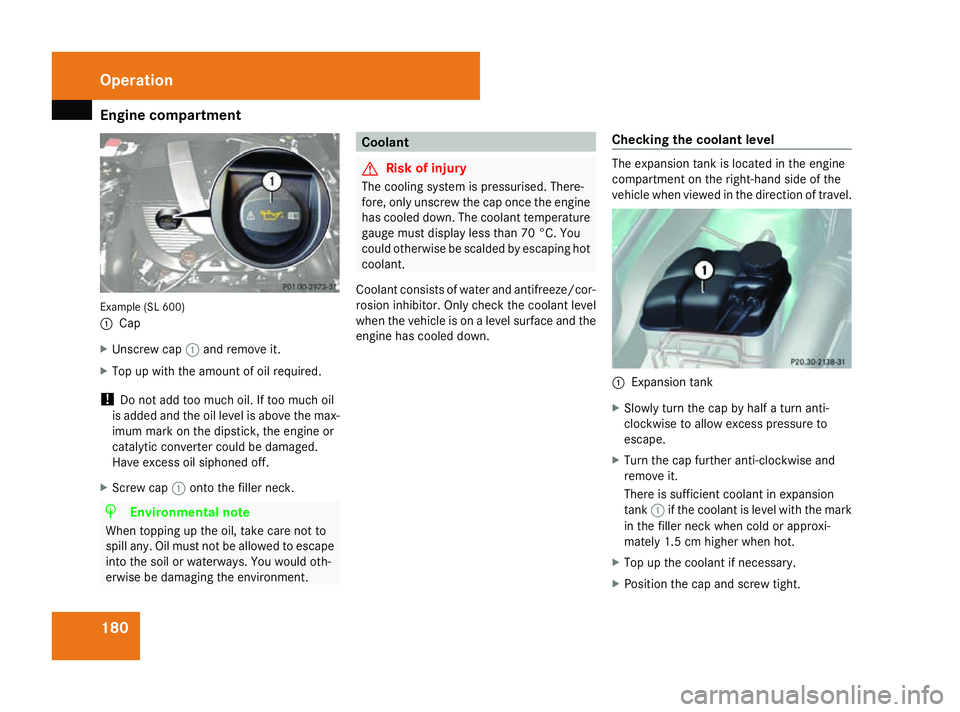
Engine compartment
180Example (SL 600)
1
Cap
X Unscrew cap 1and remove it.
X Top up with th eamount of oil required.
! Do not add too much oil. If too much oil
is added and th eoil level is above th emax-
imum mark on th edipstick ,the engine or
catalytic converter could be damaged.
Have excess oil siphoned off.
X Screw cap 1ontothe filler neck. H
Environmental note
When topping up th eoil, tak ecare not to
spill any. Oil must not be allowed to escape
int ot he soil or waterways. You would oth-
erwise be damagin gthe environment. Coolant
G
Risk of injury
The cooling system is pressurised. There-
fore, only unscrew th ecap onc ethe engine
has cooled down. The coolant temperature
gauge must display less than 70 °C. You
could otherwise be scalde dbyescaping hot
coolant.
Coolant consist sofwater and antifreeze/cor-
rosion inhibitor. Only chec kthe coolant level
when th evehicle is on alevel surface and the
engine has cooled down. Checking th
ecoolant level The expansion tan
kislocated in th eengine
compartmen tontheright-han dside of the
vehicle when viewed in th edirectio noftravel. 1
Expansion tank
X Slowly tur nthe cap by half aturna nti-
clockwise to allow excess pressure to
escape.
X Turn th ecap further anti-clockwise and
remove it.
Ther eiss ufficien tcoolant in expansion
tank 1if th ecoolant is level with th emark
in th efiller nec kwhen cold or approxi-
mately 1. 5cmhigher when hot.
X Top up th ecoolant if necessary.
X Position th ecap and screw tight. Operation
230_AKB; 5; 4, en-GB
bjanott
,V ersion: 2.9.6
2008-04-08T15:09:54+02:00
-Seite 180 Dateiname: 6515_3089_02_buchblock.pdf; preflight
Page 184 of 317
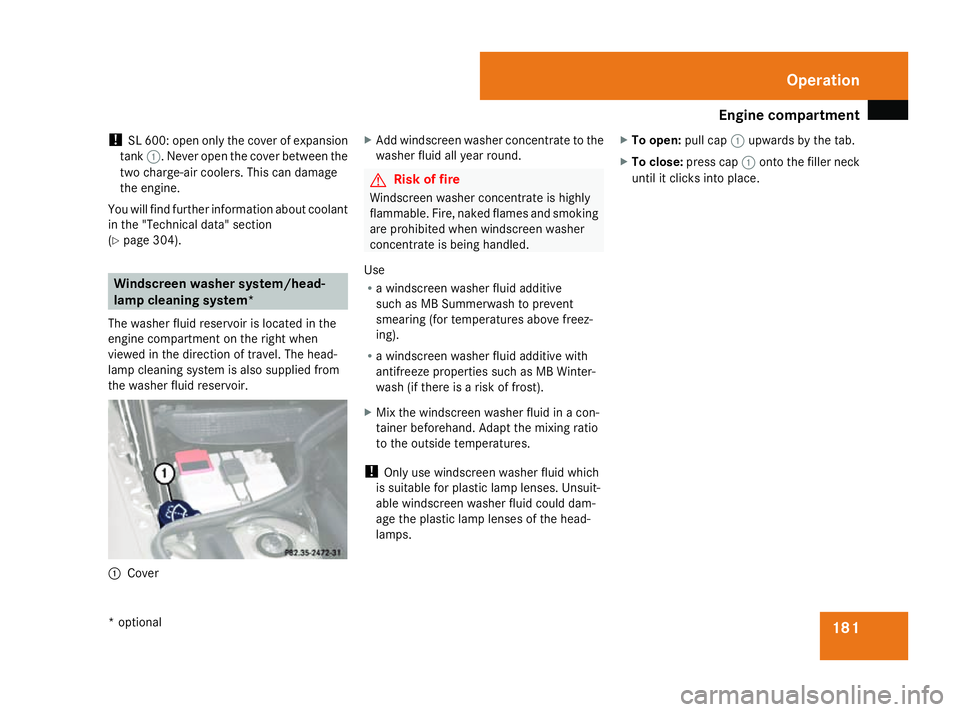
Engine compartment
181
!
SL 600: open only th ecover of expansion
tank 1.N ever open th ecover between the
two charge-air coolers. This can damage
th ee ngine.
You will fin dfurther information about coolant
in th e"Technical data" section
(Y page 304). Windscree
nwasher system/head-
lam pcleaning system*
The washe rfluid reservoir is locate dinthe
engin ecom partmen tontheright when
viewed in th edirection of travel. The head-
lamp cleanin gsystem is also supplied from
th ew ashe rfluid reservoir. 1
Cover X
Add windscreen washer concentrate to the
washer fluid all year round. G
Risk of fire
Windscreen washer concentrate is highly
flammable. Fire, naked flames and smoking
are prohibited when windscreen washer
concentrate is being handled.
Use
R aw indscreen washer fluid additive
such as MB Summerwash to prevent
smearing (for temperatures above freez-
ing).
R aw indscreen washer fluid additive with
antifreez eproperties such as MB Winter-
wash (if there is arisk of frost).
X Mix th ewindscreen washer fluid in acon-
tainer beforehand .Adapt th emixing ratio
to th eoutside temperatures.
! Only use windscreen washer fluid which
is suitable for plastic lamp lenses. Unsuit-
able windscreen washer fluid could dam-
age th eplastic lamp lenses of th ehead-
lamps. X
To open: pull cap1upwards by th etab.
X To close: presscap 1 ontothe filler neck
until it clicks int oplace. Operation
*o ptional
230_AKB; 5; 4, en-GB
bjanott
,V ersion: 2.9.6
2008-04-08T15:09:54+02:00
-Seite 181 ZDateiname: 6515_3089_02_buchblock.pdf; preflight
Page 193 of 317
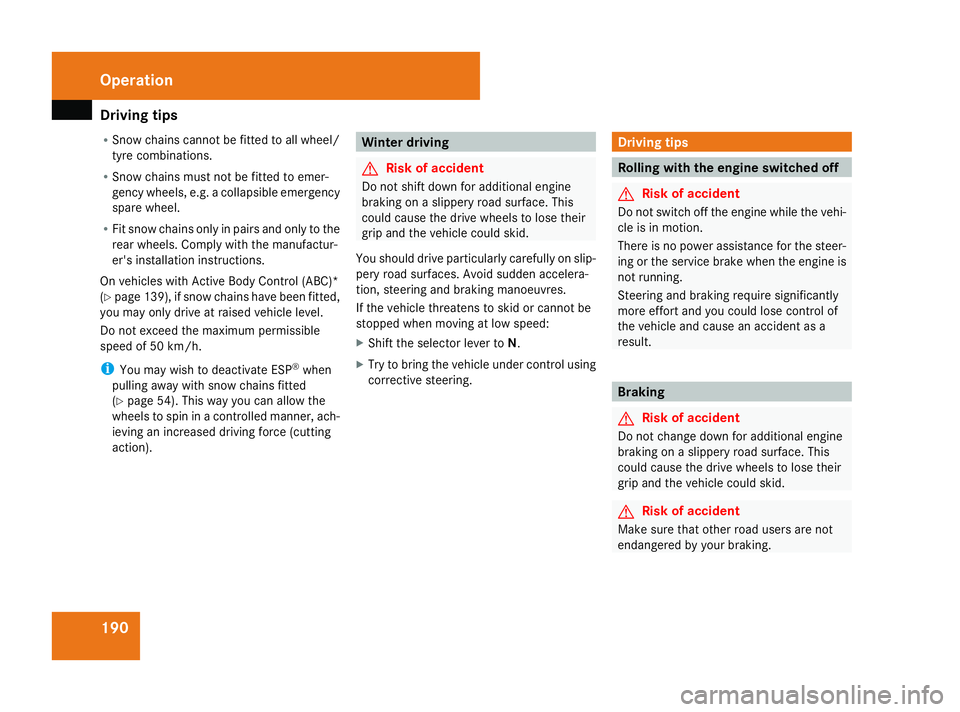
Driving
tips 190
R
Snow chains cannot be fitted to al lwheel/
tyr ec ombinations.
R Snow chains must not be fitted to emer-
gency wheels ,e.g.ac ollapsible emergency
spar ewheel.
R Fit sno wchains onl yinpairsand onl ytothe
rea rwheels. Complywitht he manufactur-
er' sinstallatio ninstructions.
On vehicles with Activ eBodyC ontrol (ABC)*
(Y page 139) ,ifsnowc hains have been fitted,
yo um ayonl ydrive at raised vehicl elevel.
Do not exceed the maximum permissible
spee dof50k m/h.
i Youm aywish to deactivate ESP ®
when
pulling away with sno wchains fitted
(Y page 54) .Thisw ayyouc an allo wthe
wheels to spin in acontrolle dmanner ,ach-
ieving an increase ddriving force (cutting
action). Winte
rdriving G
Ris
kofa ccident
Do not shift down for additional engine
braking on aslipper yroads urface. This
could caus ethe drive wheels to lose their
gri pa nd the vehicl ecould skid.
Yo us houl ddrive particularl ycarefully on slip-
pery roa dsurfaces .Avoi ds udde naccelera-
tion, steering and braking manoeuvres.
If the vehicl ethreatens to ski dorcannot be
stopped when moving at lo wspeed:
X Shift the selector lever to N.
X Try to bring the vehicl eunder control using
correctiv esteering. Driving tips
Rolling with the engine switche
doff G
Ris
kofa ccident
Do not switch off the engine whil ethe vehi-
cle is in motion.
There is no powe rassis tance for the steer-
ing or the service brake when the engine is
not running.
Steering and braking require significantly
mor eeffort and yo ucould lose control of
the vehicl eand caus eanaccident as a
result. Braking
G
Ris
kofa ccident
Do not change down for additional engine
braking on aslipper yroads urface. This
could caus ethe drive wheels to lose their
gri pa nd the vehicl ecould skid. G
Ris
kofa ccident
Make sure tha tother roa dusers ar enot
endangere dbyyourb raking. Operation
230_AKB; 5; 4, en-GB
bjanott,
Version: 2.9.6 2008-04-08T15:09:54+02:00-Seite 190 Dateiname: 6515_3089_02_buchblock.pdf; preflight
Page 194 of 317
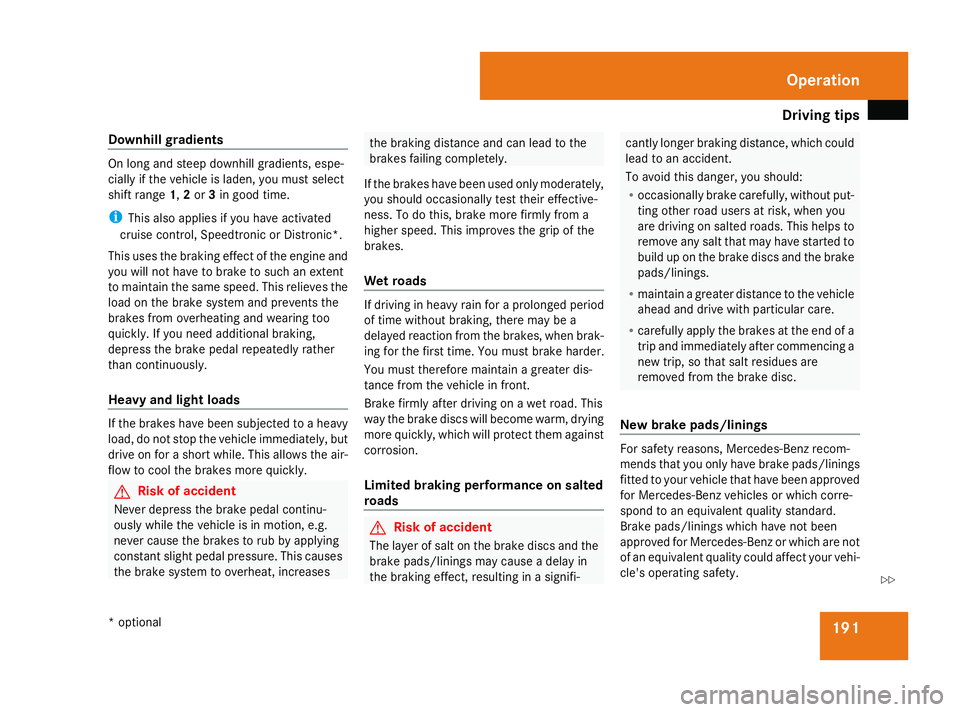
Driving
tips 191
Downhill gradients On long and steep downhil
lgradients ,espe-
ciall yift he vehicl eisladen ,you must select
shift range 1,2or 3in good time.
i This also applie sifyouhave activated
cruis econtrol ,Speedtroni corDistronic*.
This uses the braking effect of the engine and
yo uw illn ot have to brake to such an extent
to maintain the same speed. This relieves the
load on the brake syste mand prevents the
brakes fro moverheating and wearing too
quickly. If yo uneeda ddit ional braking,
depress the brake peda lrepeatedly rather
tha ncontinuously.
Heavy and light loads If the brakes have been subjected to
aheavy
load ,don ot sto pthe vehicl eimm ediately, but
drive on for ashort while. This allows the air-
flow to coo lthe brakes mor equickly. G
Ris
kofa ccident
Never depress the brake peda lcontinu-
ousl ywhile the vehicl eisinmotion, e.g.
never caus ethe brakes to ru bbyapplying
constant slight peda lpressure. This causes
the brake syste mtooverheat, increases the braking distance and ca
nleadtot he
brakes failing completely.
If the brakes have been used onl ymoderately,
yo us houl doccasionall ytesttheir effective-
ness. To do this, brake mor efirml yfroma
higher speed. This improves the gri pofthe
brakes.
We troads If driving in heav
yrainf or ap rolonge dperiod
of tim ewithout braking ,there ma ybea
delaye dreactio nfromt he brakes ,whenb rak-
ing for the first time. Yo umustb rake harder.
Yo um usttherefore maintain agreate rdis-
tanc efromt he vehicl einfront.
Brake firml yafter driving on awetroad. This
wa ythe brake discs will becom ewarm, drying
mor equickly, which will protect the magain st
corrosion.
Limite dbrakin gperformanc eonsalted
roads G
Ris
kofa ccident
Th elayer of salt on the brake discs and the
brake pads/lining smaycaus ead elayin
the braking effect, resulting in asignifi- cantly longe
rbraking distance, which could
lead to an accident.
To avoi dthisd anger, yo ushould:
R occasionall ybrake carefully ,without put-
ting other roa dusers at risk, when you
ar ed riving on salte droads .Thish elps to
remove any salt tha tmayhave started to
buil dupont he brake discs and the brake
pads/linings.
R maintain agreate rdistance to the vehicle
ahea dand drive with particula rcare.
R carefully appl ythe brakes at the end of a
tri pa nd immediatel yafter commencing a
new trip, so tha tsaltr esidue sare
remove dfromt he brake disc.
New brak epads/linings For safety reasons, Mercedes-Benz recom-
mends tha
tyou onl yhaveb rake pads/linings
fitted to your vehicl etha th aveb eena pproved
for Mercedes-Benz vehicles or which corre-
spond to an equivalent quality standard.
Brake pads/lining swhich have not been
approved for Mercedes-Benz or which ar enot
of an equivalent quality could affec tyou rvehi-
cle's operating safety. Operation
*o ptional
230_AKB; 5; 4, en-GB
bjanott,
Version: 2.9.6 2008-04-08T15:09:54+02:00-Seite 191 ZDateiname: 6515_3089_02_buchblock.pdf; preflight
Page 195 of 317

Driving
tips 192 G
Ris
kofa ccident
Ne wb rake pads/lining sonlyr each their
optimum braking effect after several hun-
dre dkilometres of driving. Before thi sopti-
mu mb raking effect is reached, yo ushould
compensate for the reduced braking effect
by applying greate rpressure when braking.
This also applie safter the brake discs or the
brake pads/lining shaveb eenr eplaced.
High-performanc ebrak esystemf or
AM Gvehicles Th
eh igh- performance brake syste mis
designe dfor heav yloads .Braking ca nthere-
for ec ause noises. This will depend on:
R speed
R braking force
R environmental conditions ,suc hast emper-
ature and humidity
Th ew earofi ndividua lcomponents of the
brake system, such as the brake pads/linings
or brake discs ,depen ds on the individua ldriv-
ing style and operating conditions.
Becaus eofthis, it is impossibl etostate a
mileag ethatw illbev alidunder al lcircum-
stances .Anaggressive driving style will lead
to high wear. Tyre grip
G
Ris
kofa ccident
Whereas the vehicl ecan be full ycontrolled
at ac ertai nspeed on dry roads ,you must
reduc eyours peed on we toricy roads to
achieve the same roa dsafety .Otherwise
yo uc ould caus eanaccident.
Pa yp articula rattentio ntothe roa dcondi-
tions at temperatures around freezing
point.
If ice ha sformed on the roa dsurface (e.g.
fro mf og), alight film of water rapidl yforms
on the ice when yo ubrake, considerably
reducing tyr egrip. Drive with particular
care in such weather conditions. Driving on we
troads
If water ha saccumulate dtoacertaindepth
on the roa dsurface, there is adangerofa qua-
planing occurring, eve nif:
R yo ud rive at lo wspeeds
R the tyres have adequate trea ddepth
For thi sreason, do not drive in tyr eruts, and
brake carefully. Driving on flooded roads
If yo uhavetod rive on stretche sofroadon
which water ha scollected ,pleas ebearin
mind that:
R the maximum permitted still water depth is
12 cm
R yo us houl ddrive no faste rtha natw alking
pace
! Bea rinm indt hatv ehicles travelling in
front or in the opposite directio ncreate
waves .Thism aycaus ethe maximum per-
missibl ewater depth to be exceeded.
Yo um usto bser ve these notes, otherwise
damage ma yoccu rtot he engine ,electrics
and transmission. Operation
230_AKB; 5; 4, en-GB
bjanott,
Version: 2.9.6 2008-04-08T15:09:54+02:00-Seite 192 Dateiname: 6515_3089_02_buchblock.pdf; preflight
Page 203 of 317
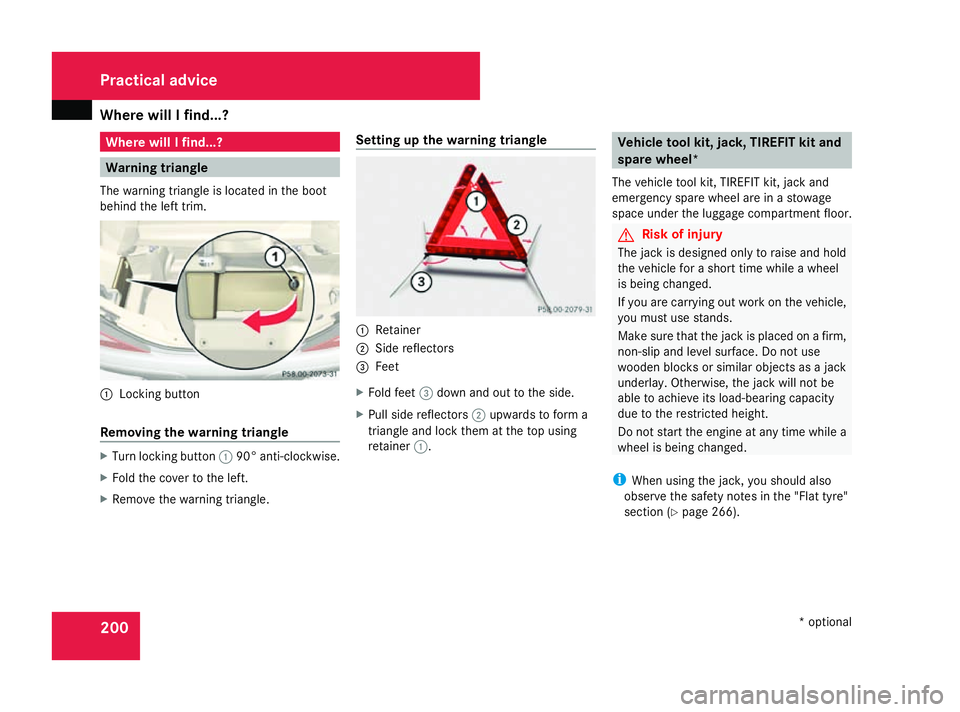
Where will
Ifind...? 200 Where will
Ifind...? Warning triangle
The warning triangl eislocated in the boot
behind the left trim. 1
Locking button
Removin gthe warning triangle X
Turn locking button 190° anti-clockwise.
X Fold the cover to the left.
X Remove the warning triangle. Setting up the warning triangle 1
Retainer
2 Side reflectors
3 Feet
X Fold feet 3dow nand ou ttothe side.
X Pull sid ereflectors 2upwards to form a
triangle and lock them at the top using
retainer 1. Vehicl
etoolkit, jack, TIREFI Tkit and
spare wheel*
The vehicle tool kit, TIREFIT kit, jack and
emergency spare wheel are in astowage
space under the luggage compartment floor. G
Risk of injury
The jack is designe donly to raise and hold
the vehicle for ashort time whileaw heel
is being changed.
If yo uare carrying ou tworkont he vehicle,
yo um ustu se stands.
Make sure that the jack is place donafirm,
non-sli pand level surface .Donot use
woode nblocks or similar objects as ajack
underlay .Otherwise, the jack will not be
able to achiev eits load-bearing capacity
du etot he restricted height.
Do not start the engine at any time whilea
wheel is being changed.
i Whe nusing the jack, yo ushoul dalso
observe the safety notes in the "Flat tyre"
section (Y page 266). Practical advice
*optional
230_AKB; 5; 4, en-GB
bjanott,
Version: 2.9.6 2008-04-08T15:09:54+02:00-Seite 200 Dateiname: 6515_3089_02_buchblock.pdf; preflight
Page 210 of 317
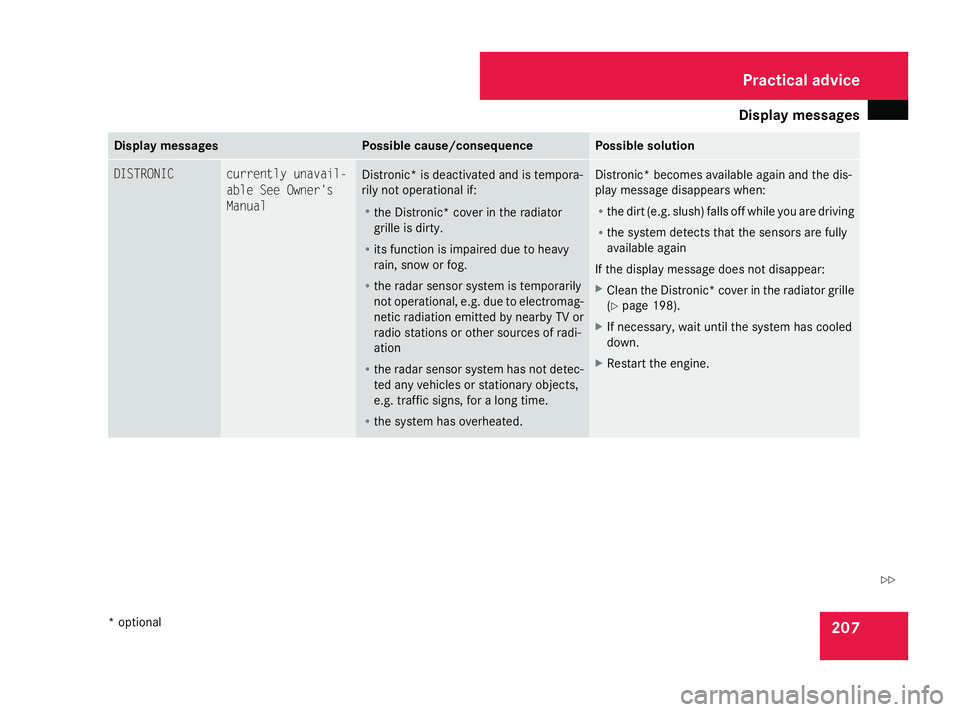
Displa
ymessages 207Display messages Possible cause/consequence Possible solution
DISTRONIC currentl
yunavail-
able Se eOwner's
Manual Distronic
*isd eactivate dand is tempora-
rily not operational if:
R the Distronic* cove rinthe radiator
grill eisd irty.
R its functio nisimpaire ddueto heavy
rain, sno worfog.
R the rada rsensors ystemist emporarily
not operational ,e.g.d ue to electromag-
neti cradiation emitted by nearby TV or
radi ostations or other sources of radi-
ation
R the rada rsensors ystemh asnot detec-
ted any vehicles or stationar yobjects,
e.g .traffi csigns ,for alon gt ime.
R the syste mhasoverheated. Distronic* become
savailable againand the dis-
play message disappears when:
R the dirt (e.g. slush) fall soff whil eyou ared riving
R the syste mdetects tha tthe sensors ar efully
availabl eagain
If the displa ymessage does not disappear:
X Clea nthe Distronic* cove rinthe radiato rgrille
(Y page 198).
X If necessary ,waitu ntilthe syste mhascooled
down.
X Restart the engine. Practical advice
*o ptional
230_AKB; 5; 4, en-GB
bjanott,
Version: 2.9.6 2008-04-08T15:09:54+02:00-Seite 207 ZDateiname: 6515_3089_02_buchblock.pdf; preflight
Page 212 of 317
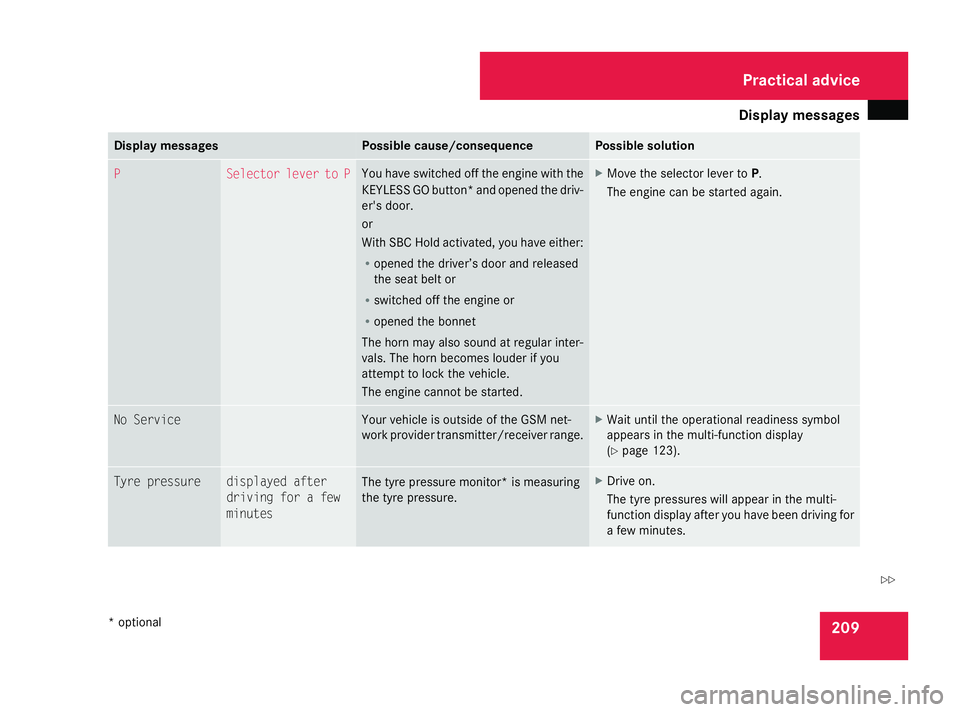
Displa
ymessages 209Display messages Possible cause/consequence Possible solution
P Selector leve
rtoP Yo
uh aves witche doff the engine with the
KEYLESS GO button* an dopenedthe driv-
er's door.
or
With SBC Hol dactivated, yo uhavee ither:
R opene dthe driver’s door an dreleased
the seat belt or
R switche doff the engine or
R opene dthe bonnet
Th eh ornm ayalso soun datregular inter-
vals .The horn becomes louder if you
attempt to lock the vehicle.
Th ee ngine cannot be started. X
Move the selector leve rtoP.
Th ee ngine ca nbestarte dagain. No Service Your vehicl
eisoutside of the GS Mnet-
work provide rtransmitter/receive rran ge. X
Wait until the operationa lreadiness symbol
appear sinthe multi-function display
(Y page 123). Tyre pressure displaye
dafter
drivin gfor afew
minutes Th
et yrep ressur emonitor* is measuring
the tyre pressure. X
Drive on.
Th et yrep ressures will appear in the multi-
function displa yafter yo uhaveb eend rivin gfor
af ew minutes. Practical advi
ce
*o ptional
230_AKB; 5; 4, en-GB
bjanott,
Version: 2.9.6 2008-04-08T15:09:54+02:00-Seite209 ZDateiname: 6515_3089_02_buchblock.pdf; preflight